It has been said that there are three white poisons in the western world: white sugar, white flour, and white toilets. When we observe the position of the rectum in a sitting position, it is closed because it is horizontal. Most of the world evacuate their bowels while squatting, where the rectum is lower than the knees and provides a position which allows the rectum to open and eliminate contents of the sigmoid and descending colon. I doubt that we will change the fixtures in our bathrooms. We can develop greater integrity to our lower abdomen and their organs for more optimal function.
Because I specialize in cleansing and detoxification, primarily of the bowels, I consider it my responsibility to educate others in developing and maintaining healthy bowels. During my years of study in holistic practice, I have learned many techniques which address aspects of bowel integrity. The following suggestions are those which I consider most beneficial, whether they be exercises, energetic practices, soft tissue work, or methods to clear emotional impediments.
Physical Exercises
I recommend two exercises to encourage further elimination after a colonic, or each morning upon rising, which stimulate the pressure points in the bowel. The first is a cross crawl exercise much like marching in a band. When the legs are brought up above hip level, it stimulates the pressure points in the IC valve and the sigmoid colon.

figure 1
The second exercise is a twisting exercise, which is done by locking the hips and turning side to side. If you can imagine the splenic and hepatic flexure much like a wash cloth, the twisting motion “wrings out” the corners, again activating peristalsis.
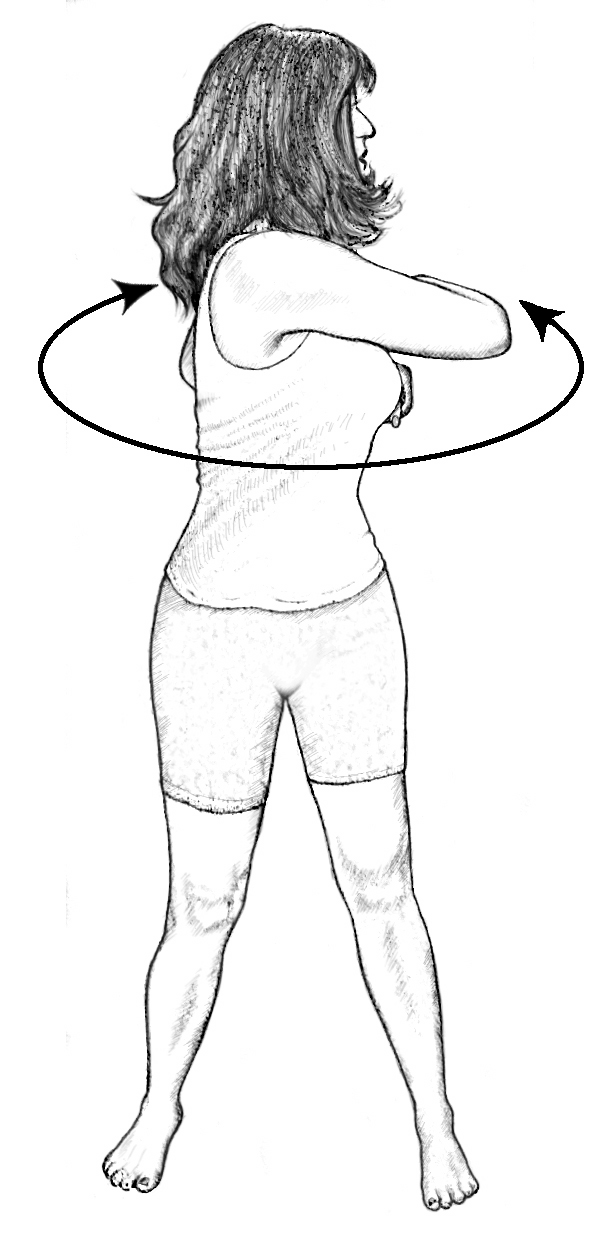
figure 2
Doing these exercises for 30 seconds after a colonic will create greater peristalsis causing material to move more easily and rhythmically. I ask patients to do this to insure complete elimination prior to introduction of reflorastation as well as at home each morning.
Energetic exercises
There are three exercises I suggest which bring more energy into the lower abdominal cavity, especially the first chakra. These may be attributed to Chinese medicine and Chi Gong. The first is a circular motion starting below the umbilicus, going in either a clockwise or counterclockwise direction for 81 rotations. One can create friction on the skin or simply work in the energy field, as long as the hand is within the first three inches of the body. Change directions and administer 81 rotations in the opposite direction. During this exercise, the arm and hand may become fatigued. If so, just stop below the umbilicus, change hands, and continue with the exercise. I have had numerous occasions where patients would complain of “having an urge” but not being able to eliminate. After this exercise, the bowels are more responsive.
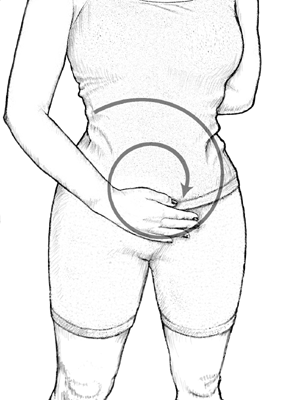
figure 3
Although I was taught that the beginning direction was unimportant, I suggest going against the natural direction of the colon first (up the left side, across the center and down the right) and finishing with the natural direction of material flow (up the right side, across the center and down the left). I perceive this as a winding up with the counter flow and a releasing with the natural flow.
The second exercise I learned from a Chi Gong master practitioner, who spoke of bringing the chi deep into the abdomen where our source of physical energy develops. Sitting on a small pillow in a cross legged position, keep the back straight. Pretend that your pelvis is sitting on a ball about the size of a soft ball and begin to rotate the entire body, first in one direction and then to the other. Continue this exercise for up to five minutes.
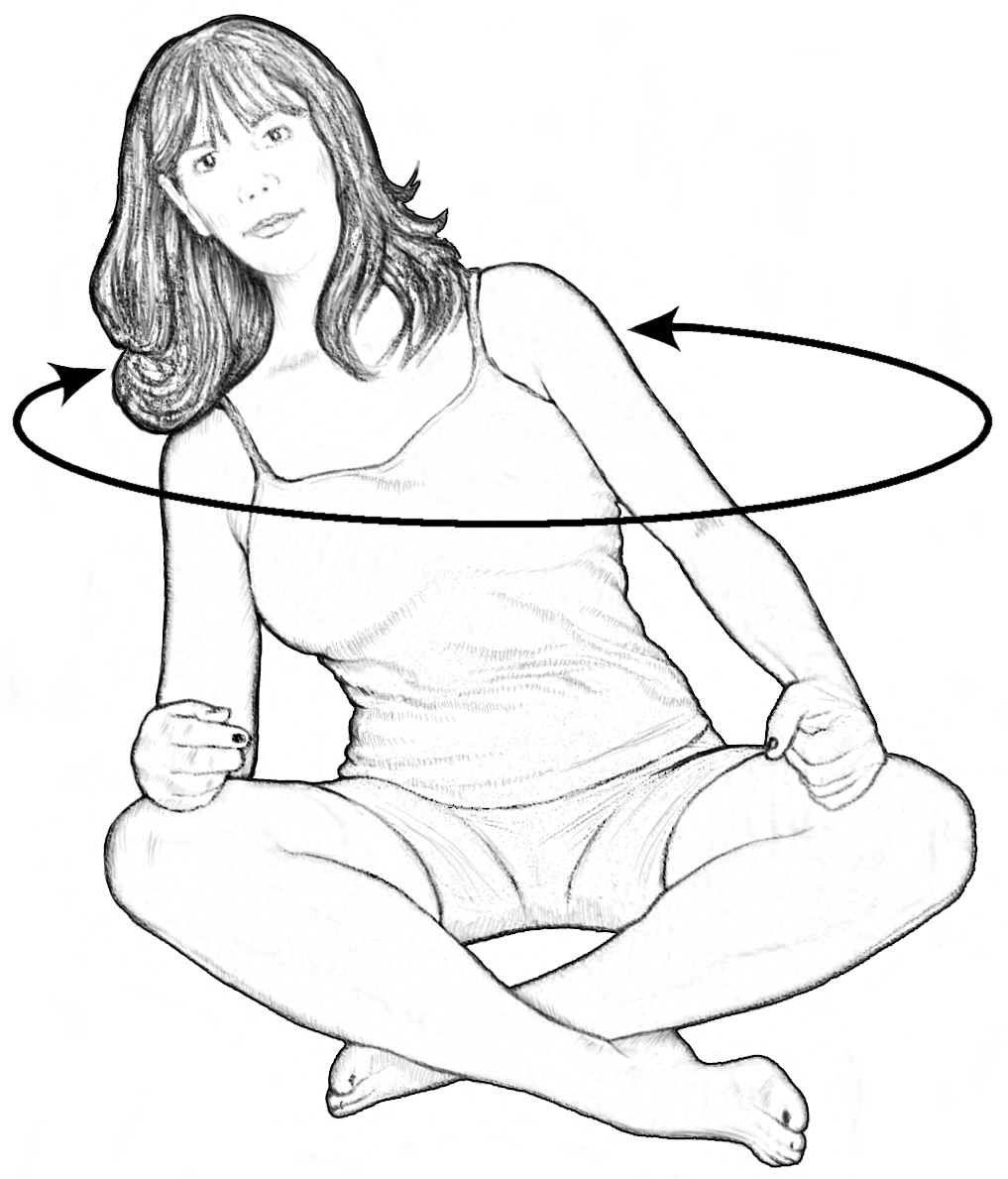
figure 4
The third exercise was also shared by this master and utilizes the energy from our hand chakra to vitalize the lower abdomen. Many patients have weakened and flabby abdominal muscles which this cupping will also stimulate. While standing, preferably with knees slightly bent, tighten the abdominal muscles. Begin to cup, alternating hands, covering the entire abdomen. Beginners should be slightly forceful, increasing the strength of the contact as they are able. One minute of cupping is sufficient for beginners, building up to five minutes within a months time. After building up to 5 minutes, then increase the intensity of the impact.
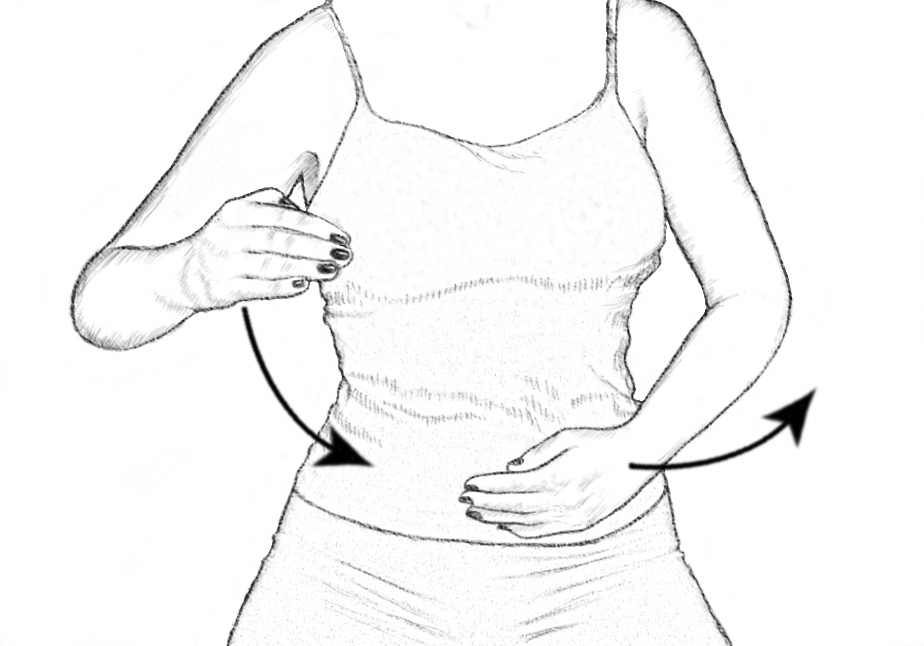
figure 5
Soft Tissue Work
There are several forms of body work which focus on the lower abdomen. While administering a colonic I utilize either or both of the following techniques, when the patient is having little response. These can be self administered as well, for any type of lower abdominal concerns and discomfort.
The first is a biomagnetic technique which utilizes the first two fingers of each hand as “touching fingers”. The “X” point is a hold point, using either hand. The other five points are held for a minimum of 6 seconds (although I hold until I feel a synchronized pulse between my hands). It doesn’t matter which point is held first, or in what order. I tend to hold points #1 first, followed by #5. I consider these the master points of the colon, representing the IC valve and sigmoid colon. Points #2, #3, and #4 can be in any order. When this is completed, hold the following two points simultaneously: #2 and #4, followed by #1 and #5, finishing with #3 and the “X”.
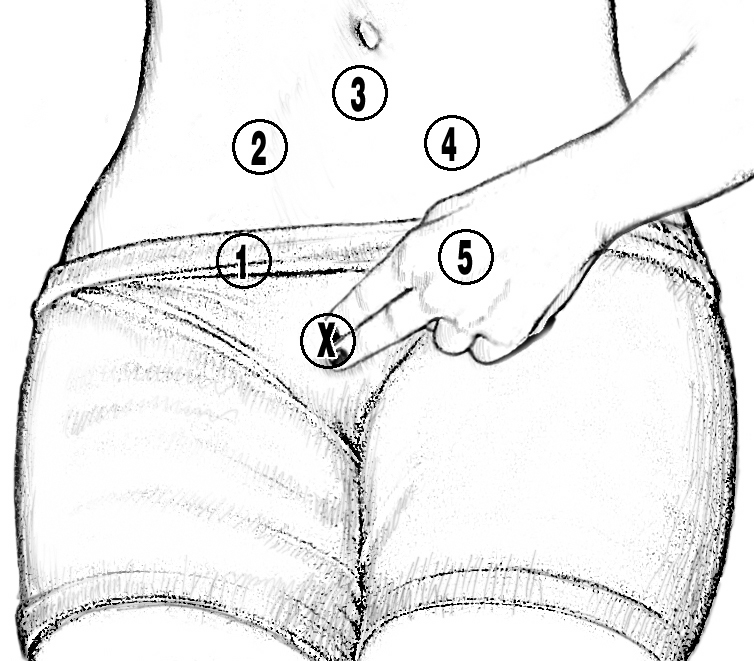
figure 6
There is no need for depth or pressure with the biomagnetic technique. Light touch, whether on the skin or through clothing, is all that is needed. We are acting much like the battery of a car, “jump starting” a weaker system. People who self administers this technique, will achieve a 50% “charge”. I have taught this technique to children so they can participate in helping a loved one in the healing process. They are able to combine an uncontaminated belief system and youthful vital force just by touching with focus.
The second technique is from my varied studies of Tom Bowen (see Explore! article Neural Touch Vol 13 #3) The pressure or lack of pressure (since this is an energetic technique) is similar to the biomagnetic, although utilizing a movement.
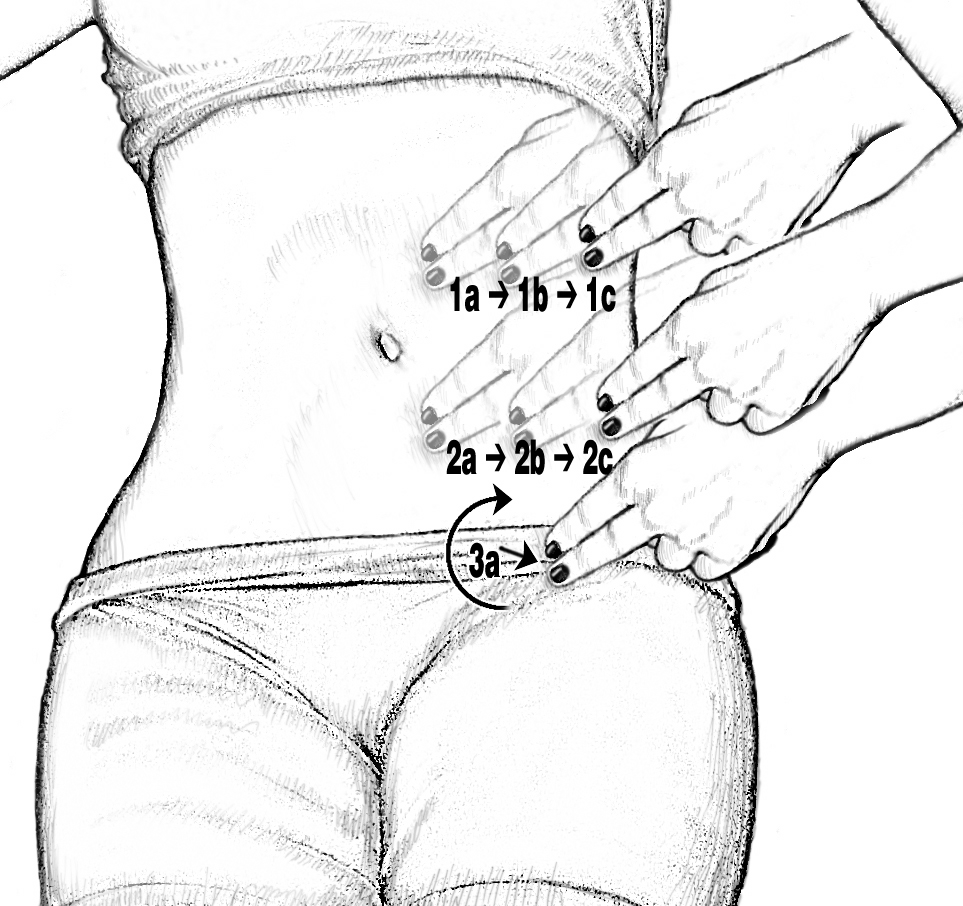
figure 7
There are three lateral moves above the umbilicus, three below the umbilicus and one circular movement half way between the umbilicus and the inguinal ligament. The upper moves (#1a, #1b, #1c) are done first, addressing indigestion, colic, and gastric disturbances. The lower moves (#2a, #2b, #2c) are administered second, addressing urinary difficulties. The last move (#3a) is done by moving straight toward the inguinal ligament, then circular: going inward, upward, and outward. This is an energetic move for the sigmoid colon. These moves are then repeated on the right side in the same order with point #3a addressing the IC valve. After completing these moves, use your thumb to “pluck” the vastus lateralis tendon just above the knee, first left and then right.
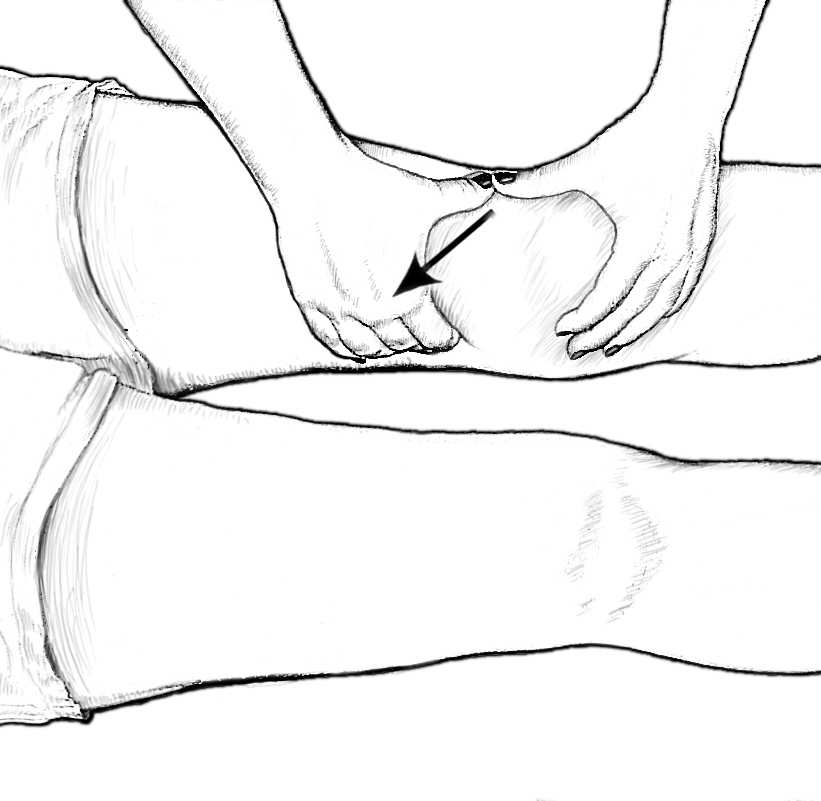
figure 8
When a patient presents with reflux, I often see constipation contributing (or backing up) to the condition. After addressing the bowels and achieving daily, easy elimination, the following technique begins to move the upper digestive tract into correct positioning. Standing on the left side of the supine patient, have the patient’s left arm point to the ceiling. Using our left hand, slide the fingers gently under the ribs. As we pull down on the left arm with our right hand (the patient needs to resist) we firmly pull laterally (not to the point of pain) under the ribs. Repeat two or three times. This may need to be repeated weekly until the condition subsides.
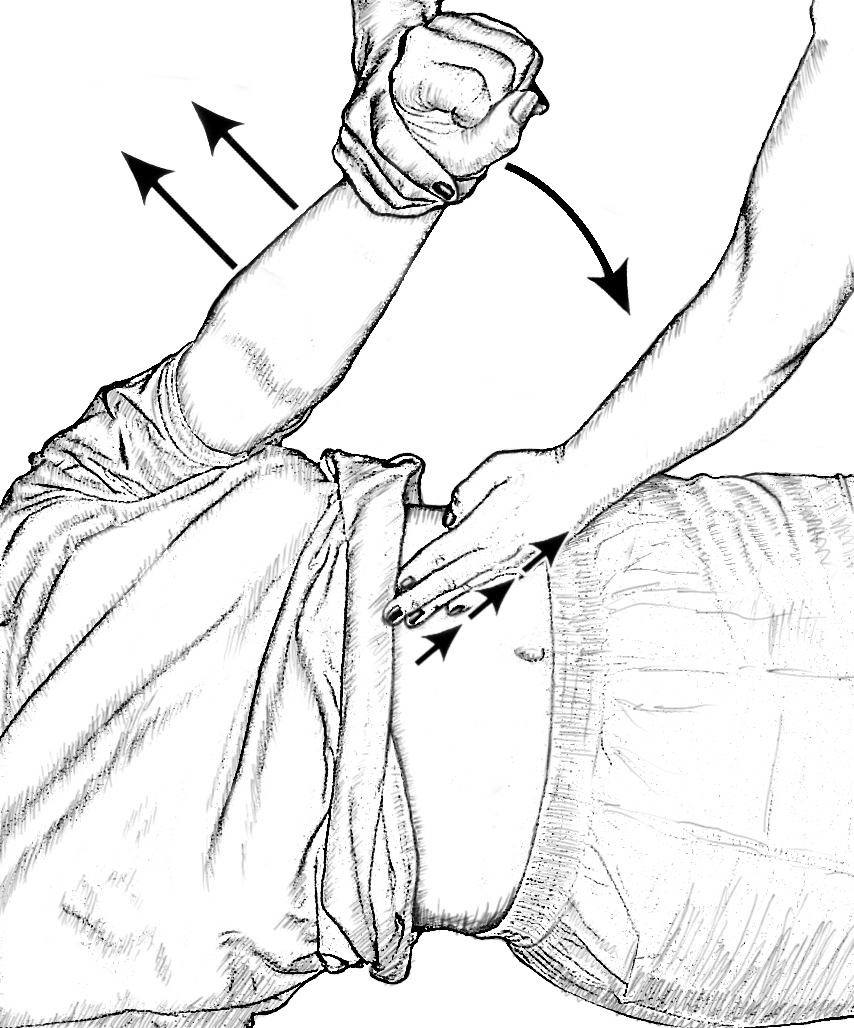
figure 9
Addressing Emotional Impediments
Many individuals, especially women, hold emotions in their colon. They often need to address the reasons behind the “holding on”, as well as the frustration and anger with an organ they believe is not working, when in fact it is working perfectly in accordance with their belief system and life choices.
The first exercise involves letter writing. I suggest they write a letter to their colon, expressing their feelings, such as the anger and frustration. It is important to keep the focus on the colon and not wander onto other subjects unless they relate back to the colon. They are encouraged to write about other peoples’ expectations and demands which influence their habits (“Hurry up, we only have one bathroom for four children,” or “I can’t take time at work, I’m a teacher and there’s no one to watch the students.”) When their letter is finished, they are to brew a cup of tea and reflect on what they have written for 15 minutes.
In a sealed envelope I have given them the second portion of this exercise. After reflection, they are to open the envelope. The instructions are to write a letter FROM their colon to themselves, letting the feelings of the colon spill onto the paper just as they had spilled their emotions onto the paper about their colon. When they begin an understanding of this marvelous organ, by opening up the communication between their emotions and its effect on various systems of the body, systems frequently respond quickly and continuously to this cathartic process.
Disclosure Writing
Perhaps the most powerful writing exercise is disclosure writing, which is quite different from journal writing. When an individual journals, they have the option of writing about anything. During this writing, if the person hits upon a sensitive area, or they become emotionally uncomfortable or fearful, they might turn to another subject and explore it instead. This discounts the subconscious and unconscious minds.
Disclosure writing is a 20 minute exercise on four consecutive days on one topic. The statement written at the top of the page is: “My deepest thoughts and feelings about _____ are:” It is important to do “pen to paper” writing, without editing, erasing, or spell checking. One must use pen or pencil and paper, not a computer and write continuously. If during the exercise one cannot think of anything to say, they write their phrase: “My deepest thoughts and feelings about _____ are” and continue writing.
By setting a timer one cannot use distraction to check the time. When the buzzer goes off, you quit and continue with your day. After sleeping, repeat the exercise on the SAME topic. It is irrelevant as to what time of the day to write, only that it be four consecutive days. (i.e., One might write on a Friday evening, Saturday morning, Sunday afternoon, and complete the exercise Monday evening.) A metamorphosis occurs by the completion of the exercise.
For a patient with chronic constipation, I might put “constipation” into the blank. For someone dealing with IBS, I might suggest “anxiety” or some other appropriate emotion or aspect relating to their perception of the problem. In studies of individuals dealing with the death of a loved one, doing disclosure writing on “grief” moved them through their grief process more quickly. They were more resolved with their situation and began to participate in life as it now was. Another study took unemployed subjects, half journaled while the other half did disclosure writing on “unemployment”. The subjects who journaled had very little change in their non-working status. However, the disclosure writing subjects got jobs, stayed with them longer, received raises, and some began productive careers.
Affirmations and Self Talk
In observing individuals who utilize affirmations, I have found that they must be written and recited in such a way as to parallel the belief system without lying. When a person says with passionate energy: “But my bowel just won’t work” they are sending a strong message reinforcing the lack of function in the lower GI tract. Suggesting they say “My bowels work every day” is lying to their being. This is unproductive. Instead, I phrase a statement like this: “Although my past experience is minimal bowel response, I am embarking on a program to support healthy elimination and my body responds.” I have validated the past frustrations, mentioned the protocol which we have thoroughly discussed and stated the body’s action. This type of affirmation and self talk is valuable, believable, and successful.
Case History
M.O., a 57 year old female, was diagnosed with torturous bowel in January 2004. She had been constipated for most of her life, which was worse during pregnancies. She had chronic digestive problems, ovarian cysts, complete hysterectomy and appendectomy. After the diagnosis of torturous bowel, it was suggested that the colon be removed when she could no longer tolerate the pain. We worked for six months, addressing the physical cleansing and reflorastation of the bowel. Weekly treatments were administered to stimulate peristalsis, while discussing many of the above exercises. Margaret is now pain free and eliminates daily. She does dedicate 30 minutes every morning to supporting healthy elimination, which she considers far less inconvenient than surgery and an ostomy bag.
Conclusion
Perhaps one of the most fulfilling aspects in my practice are the calls and cards I receive from patients who have struggled for years or a lifetime, with bowel problems. When we combine our knowledge with the patient's commitment and energy, sustainable results can be achieved. I believe that it is time for our patients to move into the role of active participation in their own health, guided by our knowledge and direction.
Victoria Bowmann, D.H.M., Ph.D., earned her doctorate in homeopathic medicine from the British Institute of Homeopathy and her Ph.D. in homeopathy and natural medicine from Westbrook University from Wierton, WV. She has been in private practice in Phoenix AZ since 1978 specializing in detoxification, cleansing, and the process of increased well being.
